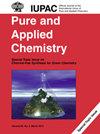Radionuclides in marine sediment
IF 2
4区 化学
Q3 CHEMISTRY, MULTIDISCIPLINARY
引用次数: 0
Abstract
Most contaminants in the sea originate from land sources. Radionuclides in sea water are transported by sea currents. Marine sediment is a physical trap for pollutants that are introduced to the environment and play an important role in radiological studies. Radionuclides from seawater bound to particulates sink to the seabed. Their resuspension causes the reintroduction of pollutants to the water column. Remobilization and horizontal/vertical transport by various processes may occur. Long-lived radionuclides become buried in sub-surface sediment. Grain size sediment classification and sediment geochemical composition all play a significant role in the development of the radionuclide content of marine sediment. Atmospheric fallout from the Chernobyl and the Fukushima accidents, atmospheric nuclear weapon testing, releases from nuclear industry plants, river runoff, and to a lesser extent directed and submarine groundwater discharges are the major sources of radionuclides in the marine environment.海洋沉积物中的放射性核素
海洋中的大多数污染物都来自陆地。海水中的放射性核素随海流漂移。海洋沉积物是污染物进入环境的物理陷阱,在辐射研究中发挥着重要作用。海水中与微粒结合的放射性核素会沉入海底。它们的再悬浮会导致污染物重新进入水体。通过各种过程可能会发生再移动和水平/垂直迁移。长寿命放射性核素会被掩埋在地下沉积物中。沉积物粒度分类和沉积物地球化学成分都对海洋沉积物放射性核素含量的发展起着重要作用。切尔诺贝利和福岛事故造成的大气沉降物、大气层核武器试验、核工业工厂的排放物、河流径流以及较小程度上的定向和海底地下水排放物是海洋环境中放射性核素的主要来源。
本文章由计算机程序翻译,如有差异,请以英文原文为准。
求助全文
约1分钟内获得全文
求助全文
来源期刊

Pure and Applied Chemistry
化学-化学综合
CiteScore
4.00
自引率
0.00%
发文量
60
审稿时长
3-8 weeks
期刊介绍:
Pure and Applied Chemistry is the official monthly Journal of IUPAC, with responsibility for publishing works arising from those international scientific events and projects that are sponsored and undertaken by the Union. The policy is to publish highly topical and credible works at the forefront of all aspects of pure and applied chemistry, and the attendant goal is to promote widespread acceptance of the Journal as an authoritative and indispensable holding in academic and institutional libraries.
 求助内容:
求助内容: 应助结果提醒方式:
应助结果提醒方式:


